Country Indonesia | Headquarters Bandung, Indonesia | |
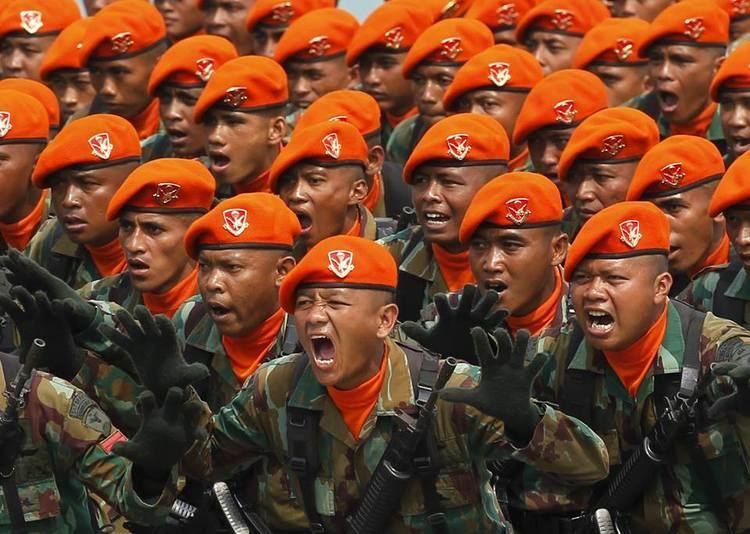 | ||
Active 17 October 1947 – present Branch TNI-AU (Indonesian Air Force) Type Air Force Special Forces Role Special Operations
Air Force Infantry Garrison/HQ Markas Komando Korpaskhasau, Margahayu, Bandung Founded 17 October 1947, West Kotawaringin Regency, Indonesia Engagements Operation Trikora, Indonesian National Revolution, Indonesia–Malaysia confrontation, Darul Islam Rebellion Similar Indonesian Air Force, Indonesian Marine Corps, Indonesian Army, Indonesian Navy, Paspampres | ||
Indonesian national forces song paskhas hymne paskhas
PASKHAS known as (Korps Pasukan Khas) is the special forces and infantry corps of the Indonesian Air Force ("TNI-AU"). This unit is also known as the Orange Berets (Baret Jingga in Indonesian) because of the colour of their service headgear. Like other elite units in the TNI-AD (Indonesian Army) and TNI-AL (Indonesian Navy), Paskhas is a ground combat unit that is capable of operating on land, sea, and air. Paskhas is trained to seize and defend airfields from enemy forces, and then prepare the airfields to be able to facilitate friendly airplanes to land. This capability is known as Operasi Pembentukan dan Pengoperasian Pangkalan Udara Depan (OP 3 UD) (Frontline Air Base Establishment and Management Operation).
Contents
- Indonesian national forces song paskhas hymne paskhas
- History
- Bravo Detachment 90
- Strength
- Combat qualifications
- Structure
- Weaponry
- References
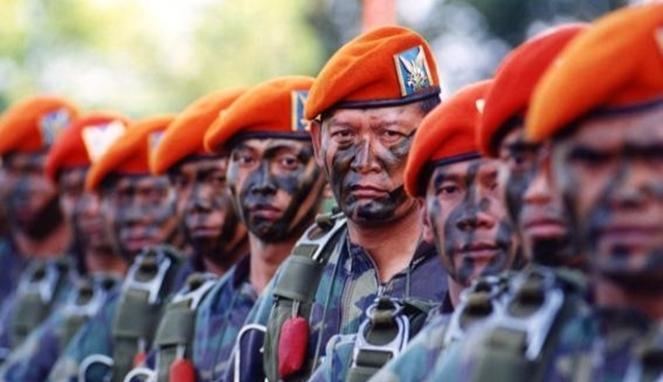
Paskhas is the only infantry and special forces unit of the Indonesian Air Force (TNI-AU) and has many air-oriented combat abilities, such as combat-control team, airfields control, combat Search and Rescue, jump master, airborne, and ground-forward air control. They also can operate as Air Traffic Controllers (ATC).
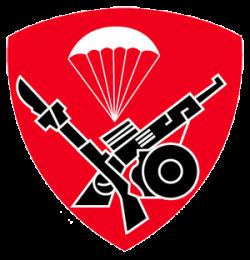
History
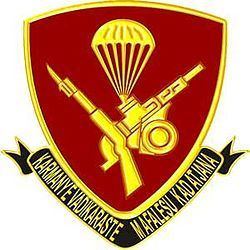
The history of Paskhas as the first airborne troops is almost as old as the Republic of Indonesia. An airborne-infiltration operation by 14 paratroopers on 17 October 1947, in Kotawaringin, Kalimantan, is marked as the birthdate of Paskhas. In the early years of the TNI-AU (established on 9 April 1946), these airborne units were called Pasukan Pertahanan Pangkalan (PPP) (Air Field Defence Troops). In April 1952, the Pasukan Gerak Tjepat (PGT) (Quick Reaction Force) was also established to strengthen the TNI-AU. In 1952, the TNI-AU ground units consisted of PPP, PGT, and PSU (Air Defence Unit). On 15 October 1962, PPP and PGT were organised into Komando Pertahanan Pangkalan Udara (Koppau) (Air Fields Defence Command). Later on 17 May 1966, Koppau was renamed to Komando Pasukan Gerak Cepat (Kopasgat) (Quick-Reaction Troops Command). There were three Kopasgat regiments, each located in Bandung, Jakarta and Surabaya. Kopasgat was transformed into the Special Forces Center in 1985, before it became Paskhas on 7 July 1997, based on the official decision of the Indonesian National Armed Forces Commander.
Bravo Detachment 90
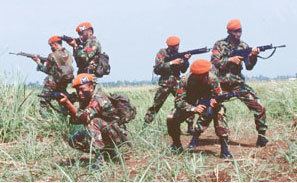
The Special Operations Unit (commando) of the Indonesian Air Force (TNI-AU) is known as "DENBRAVO 90" which is the special operations detachment originating its members from the best chosen soldiers from the Paskhas corps. "DenBravo 90" is a specialized unit for hostage rescue of Aircraft hijacking and paralyzing heavy enemy equipment.
Strength
Recently, Paskhas has had a strength of around 7,300 personnel. Every Paskhas member must have para-commando qualification, plus special air aspects qualification based on his specialisation. Paskhas is famous for their orange beret that they used in this force when the name was still "Kopasgat" in the mid-1960s. The Paskhas motto is, "Karmanye Vadikaraste Mafalesu Kadatjana" which means, "Working without hoping (for) any reward". Every Paskhas member is also equipped with a white Commando dagger made in Germany. The orange beret and Commando dagger have become trademarks of this special force. Paskhas is also known for its light-green camouflage uniform called Commando Stripe, with a stretch-out straight motif like moss-covered wood, that was very famous during the Operation Seroja in East Timor.
There is a plan to expand the Paskhas into 10 or 11 battalions with twice as many personnel as what they had previously. Recently, the placement of Paskhas has still followed the organisation of TNI-AU weapon systems, in particular the combat and support-combat aeroplanes. In other words, wherever there is a TNI-AU main airbase, ideally there is a Paskhas battalion as the airfield defence unit.
Combat qualifications
Paskhas personnel are an integral part of the TNI-AU, having their own speciality. Paskhas personnel have the qualifications and special ability to protect, defend and operate airfield facilities. The TNI-AU has high-technology weapons systems are a vital object for enemy forces to destroy.
The basic qualification for all Paskhas personnel has been "para-commando". Other qualifications are added based on his speciality. As a Combat Control team (CCT), they have combat free-fall ability, scuba diving, and combat climber. CCT must be able to infiltrate from three media aspects (sea, air, land). Beside that, this team's personnel must have one of the air aspect specialisations, such as: Air Traffic Controller (PLLU), Meteorology (Meteo), Electronic-Communication (Komlek), Combat Field Engineer (Zeni), Intelligence, Fire Fighter (PK), Ground handling, Petroleum affairs (Permi), and Combat-Health affairs (Keslap). For free-fall qualification, they must be brave enough to jump from high altitude and open the parachute at minimum altitude. The airborne technique that used was HALO (High Altitude Low Opening) or HAHO (High Altitude High Opening), with jumps around 20,000 feet (6 km; 4 mi) above sea level.
CCT also has qualifications to direct fighter planes to bomb or shoot targets from the ground (Ground Forward Air Control/GFAC). This role is very important in battle because air support must be precisely on time and target. Paskhas personnel must be able to use IT and to communicate with multimedia tools. Besides that, they are also required to have combat-intelligence ability as a collection board (Bapul) for higher command, or any other side that is needed. For example, they inform about flight facilities before plane arrive, visibility, wind speed and direction, temperature and air humidity also height and cloud type. This has been a very important factor in bombing targets and for the airborne process. All the personnel also have training as a Combat-Field Engineer (include pioneer, rope, etc.), Air Field Control (Dallan) to operate flight in some aerodrome, or Air Traffic Control (PLLU), which can control flight traffic in their sector area. Petroleum Affairs (Permi) must know and test the oil standard that fulfill the conditions and the way to fill the oil into the aeroplane.
Because Paskhas operate as commando forces, they rarely involve many personnel in their operation. Paskhas have also used unusual calls when they were doing combat mission, such as detachment, team and unit to differentiate them from regular forces.
Structure
- Paskhas Headquarter in (Sulaiman AFB, Margahayu Bandung)
- 1st Wing/Hardha Maruta (Halim Perdanakusuma Air Force Base (AFB), Jakarta)
West Regional:- Battalion 461/Cakra Bhaskara (Halim Perdanakusuma AFB, Jakarta)
- Battalion 462/Pulanggeni (Pekan Baru AFB, Riau)
- Battalion 465/Brajamusti (Supadio AFB, Pontianak)
- Battalion 467/Harda Dedali (Halim Perdanakusuma AFB, Jakarta)
- A- Independent Company (To be expanded to Battalion 469)(Polonia AFB, Medan)
- B- Independent Company (Suryadarma AFB, Subang)
- G- Independent Company (Lhokseumawe AFB, Aceh)
- H- Independent Company (Sultan Iskandar Muda AFB, Aceh)
- 2nd Wing Paskhas (Abdul Rachman Saleh AFB, Malang)
Center Regional:- Battalion 463/Trisula (Iswahyudi AFB, Madiun)
- Battalion 464/Nanggala (Abdul Rachman Saleh AFB, Malang)
- Battalion 466/Pasopati (Sultan Hasanuddin AFB, Makasar)
- Battalion 468/Sarotama (Manuhua AFB, Biak)
- E- Independent Company (Adi Sucipto AFB, Yogyakarta)
- D- Independent Company (El Tari AFB, Kupang)
- F- Independent Company (Manuhua AFB, Biak)
- 3rd Wing Paskhas / Training Center, (Sulaiman AFB, Bandung) - to become Kodiklat Paskhas
- Den Bravo-90, (Rumpin, Bogor)
- 3rd Wing Paskhas / Training Center, (Sultan Hasanuddin AFB, Makassar) - East Regional
Weaponry
Handguns
Assault Rifles
Submachine guns
Shotguns
Grenade launcher
Machine gun and other heavy weapons
